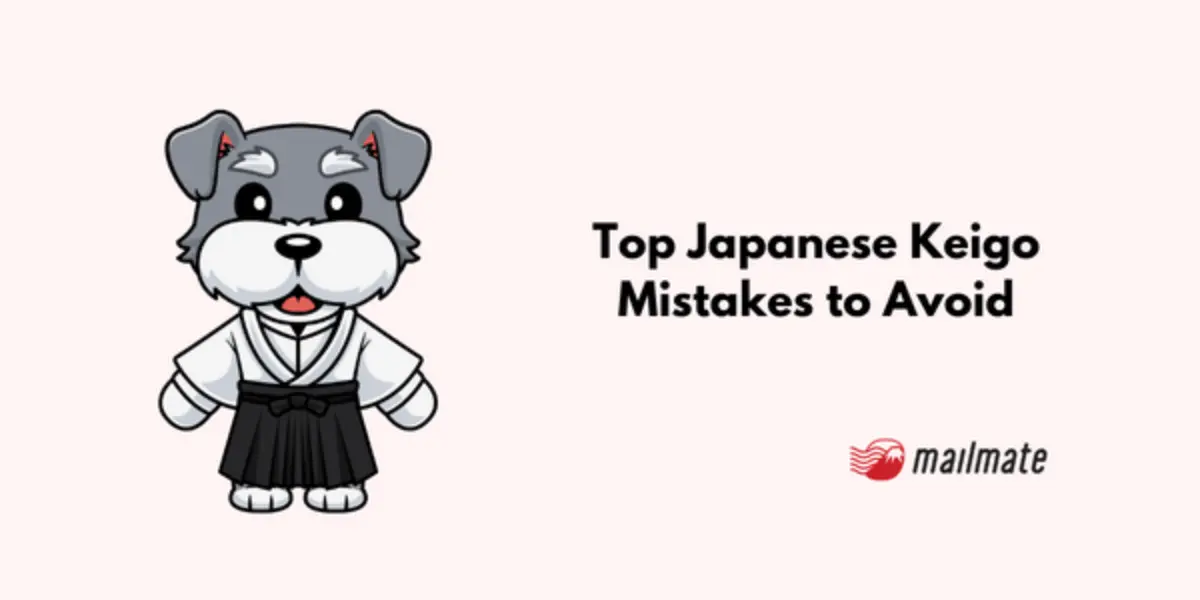Top Japanese Keigo Mistakes to Avoid

You don't need to know the ins and outs of keigo grammar construction to improve how you sound, starting from today.
Master these 5 keigo mistakes to avoid, and you will make a better impression the next time you interact with your Japanese clients.
But first we start with a quick primer on the 3 categories inside of Japanese keigo.
What is Japanese keigo?
Japanese keigo refers to three categories of polite Japanese language:
Polite language 丁寧語 = teinei go
The meaning of teineigo is polite language. Polite or courteous language in Japanese is typified by ending verb forms with ます and sentences ending with です.
This polite style or polite form is what is taught in grammar books to non native speakers and those just beginning their Japanese studies.
Respectful language 尊敬語 = kenson go
The meaning of kensongo is respectful language and it's the honorific form of the Japanese language. It's used to address one's superiors in age or rank or customers.
Respectful language (words, verb forms, and honorific prefixes) should never be used to refer to oneself.

Humble language 謙譲語 = kenjyou go
The meaning of kenjyougo in Japanese is humble language. Kenjyougo substitutes verb forms with humble words/humble forms, or it affixes humble prefixes to the verb form. For example, by adding "o" in front of certain verbs.
Humble form is used in conjunction with respectful language.
Note: Context is everything when it comes to when and how to use polite language. The scenarios that follow are within the context of a business-client relationship.
Top keigo mistakes to avoid
Mistake 1. When you want to confirm you understand what your client has said
🗙了解しました。 = ryoukai shimashita
🗙わかりました 。= wakarimashita
“I understand” is the English translation for the phrases above, which are perfectly acceptable in situations where you are not talking with a client or a superior.
However, when talking with a client, customer, business colleague, or a superior, here are the polite ways of saying you understand what the other is saying:
✔️承知いたしました。= shyouchi itashimashita
✔️かしこまりました。= kashikomarimashita
Mistake 2. When you want to convey thankfulness to your client
🗙お世話様です。 = osewa sama desu
Perhaps you've heard this phrase used to express thanks and thought that you could incorporate this into your meetings with clients. Osewa sama desu is acceptable for your co-workers or for those who are doing work for you. But when addressing your clients, use the following:
✔️お世話になります。 = osewa ni narimasu = thanking them for their future business relationship
✔️お世話になっております。= osewa ni natte orimasu = thanking them for their current business relationship
These phrases thank the other person (in this case, your client) for their care or concern. It is a social nicety that shows you value the importance of their business relationship with you.

Mistake 3. When you want to thank your clients for “hard work”
🗙ご苦労様です。= gokurousamadesu
🗙 お疲れ様です。= otsukaresamadesu
Gokurousamadesu is used in cases where a boss (superior) thanks the other (a subordinate) for their effort or hard work.
Otsukaresamadesu is used between colleagues and is an expression of acknowledgment for work done, often used as a “cushion” phrase or a greeting. Additionally, otsukaresamadesu is the correct phrase to use toward your superiors.
Japanese etiquette experts, however, advise against words of comfort or acknowledgment of hard work to one's superiors, as it can sound condescending.
Additionally, in a business setting, otsukaresamadesu is a phrase used within one's own company and not with your clients.
When you want to convey an attitude of thankfulness for something your client has done, then a more fitting phrase is the one we mentioned earlier:
✔️お世話になっております。 = osewa ni natte orimasu = thanking them for their care or concern.
Mistake 4. When you haven't seen or heard from a client in a while
🗙お久しぶりです。 = ohisashiburi desu
Ohisashiburi desu is an informal expression, equivalent to the English phrase “long time, no see.” Adding an “o” in front of a phrase does not make it honorific nor OK to use with clients.
When greeting clients you haven't seen or heard from in a long time, use the following phrase:
✔️ご無沙汰しております。= gobusata shite orimasu
This phrase apologizes for the period when you have not been in contact. (Remember, in Japanese culture, apologies are a way to move forward and don't have all the same connotations as in the US.)
Mistake 5. When you are with a client and you need to excuse yourself
🗙ちょっと、すみません。= chotto sumimasen
Chotto sumimasen is an informal phrase used to excuse yourself when you are with friends or colleagues.
However, when you're with a client and your phone rings, or you need to excuse yourself to use the bathroom, the phrase to use is the following:
✔️失礼します。すぐに戻ります。= shitsureishimasu; suguni modorimasu = I beg your pardon (as I take your leave), and I will return quickly.
When you return, you would say the following:
✔️大変失礼しました。= taihen shitsureishimashita = I have bothered you greatly. (That's a direct translation, and it's equivalent to the English “thank you for waiting.”)
Please note, getting up or leaving your clients during a meeting is considered quite rude. Of course, there are occasions, such as when drinking with clients, that you will likely need to use the bathroom or otherwise get up for a moment. In those instances, shitsureishimasu is preferable to sumimasen.
Frequently asked questions
What's the difference between honorific language and humble form?
In honorific language, respectful language (sonkeigo 尊敬 語), you express respect to the other person by elevating their actions above your own.
Humble language (kenjougo 謙譲 語) expresses respect to the other person by lowering your own actions below theirs.
When do I use keigo?
Japanese people will typically use formal form/respectful form in the following circumstances:
When conversing with those who are higher status or older than they are
When talking with customers or business associates
When talking with those who are outside of one's inner circle (out group)
When talking with those they are unfamiliar with/new acquaintances
When you want to maintain social distance from those you are talking to
When can I use casual language in Japan?
Informal language or casual speech in Japanese society is often used in the following circumstances:
When conversing with someone younger than oneself
When talking with subordinates
When talking with one's in group
When talking with those within one's inner circle, a close friend, or one's family members
In closing
As a foreign executive in Japan or a person visiting Japan, the average Japanese person won't expect you to know honorific speech or Japanese honorifics and use the respectful version of Japanese speech. At least not to the degree that your Japanese colleagues must use honorific language.
But if you're ready to learn Japanese keigo, correcting these easy-to-make keigo mistakes will help you avoid offending your Japanese clients and customers.
Master these phrases that even Japanese get wrong—and quickly improve your business manners and overall presentation.
Note: For those who wish to learn more about keigo mistakes to avoid, Keigo to kotoba zukai by the Japanese Service Manners Association is an excellent resource, which I referenced when writing this article.
Spending too long figuring out your Japanese mail?
Virtual mail + translation services start at 3800 per month. 30-day money-back guarantee.

